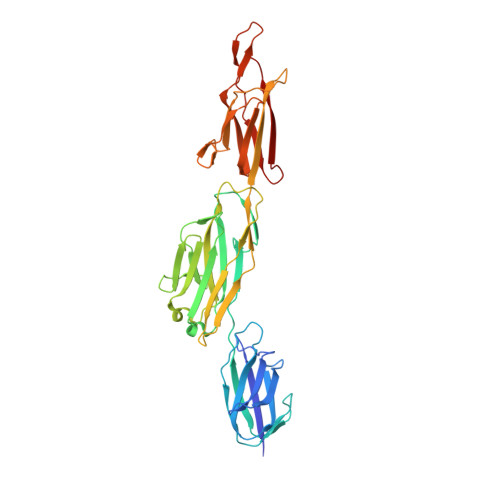Isopeptide bonds of the major pilin protein BcpA influence pilus structure and bundle formation on the surface of Bacillus cereus.
Hendrickx, A.P., Poor, C.B., Jureller, J.E., Budzik, J.M., He, C., Schneewind, O.(2012) Mol Microbiol 85: 152-163
- PubMed: 22624947
- DOI: https://doi.org/10.1111/j.1365-2958.2012.08098.x
- Primary Citation of Related Structures:
3RKP - PubMed Abstract:
Bacillus cereus strains elaborate pili on their surface using a mechanism of sortase-mediated cross-linking of major and minor pilus components. Here we used a combination of electron microscopy and atomic force microscopy to visualize these structures. Pili occur as single, double or higher order assemblies of filaments formed from monomers of the major pilin, BcpA, capped by the minor pilin, BcpB. Previous studies demonstrated that within assembled pili, four domains of BcpA - CNA(1), CNA(2), XNA and CNA(3) - each acquire intramolecular lysine-asparagine isopeptide bonds formed via catalytic glutamic acid or aspartic acid residues. Here we showed that mutants unable to form the intramolecular isopeptide bonds in the CNA(2) or CNA(3) domains retain the ability to form pilus bundles. A mutant lacking the CNA(1) isopeptide bond assembled deformed pilin subunits that failed to associate as bundles. X-ray crystallography revealed that the BcpA variant Asp(312) Ala, lacking an aspartyl catalyst, did not generate the isopeptide bond within the jelly-roll structure of XNA. The Asp(312) Ala mutant was also unable to form bundles and promoted the assembly of deformed pili. Thus, structural integrity of the CNA(1) and XNA domains are determinants for the association of pili into higher order bundle structures and determine native pilus structure.
Organizational Affiliation:
Department of Microbiology, University of Chicago, Chicago, IL 60637, USA.














